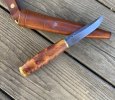No sure what you mean by "the original"?.....The knife above was authenticated by Marttiini as being made as a commemorative for the 1940 Helsinki Olympic Games....
Yes, I know it was for the 1940 Olympics, that's why I dated the pic.
The BladeForums.com 2024 Traditional Knife is available! Price is $250 ea (shipped within CONUS).
Order here: https://www.bladeforums.com/help/2024-traditional/
No sure what you mean by "the original"?.....The knife above was authenticated by Marttiini as being made as a commemorative for the 1940 Helsinki Olympic Games....
I was referring to my picture.....Yes, I know it was for the 1940 Olympics, that's why I dated the pic.

An interesting item for sure, Ilves Puukko. The Olympics that never were.....originally set to be in Tokyo for Sept-Oct 1940 but moved to Helsinki for July 1940 but 'events' elsewhere made it all impossible. Helsinki did of course eventually host the Olympics in 1952.
Thank you. I bought it from a vendor who thought it was American Indian. I like to think it's a Winter War kit knife, but I have no way of knowing.Very cool, war-time puukko?




She’s a beaut! I was wondering if it ever made it! Wow.Just in from Javanainen Forge

Thanks. It's been sitting here at my house for several weeks but I've been off traveling (of course it arrived the day after I left...). It actually came surprisingly fast from Finland.She’s a beaut! I was wondering if it ever made it! Wow.
Hey, Thank you.Best guess....Nikolai Kivinen, worked during the 1940s.....Pressed paper pahvituppi sheath so anytime from 1941 until 1950 or so



